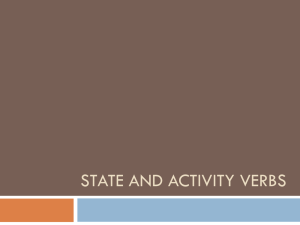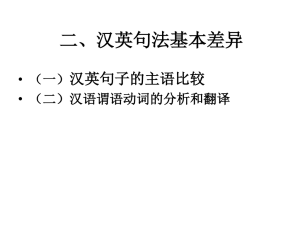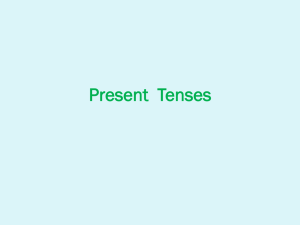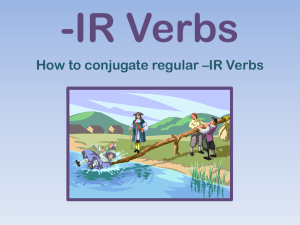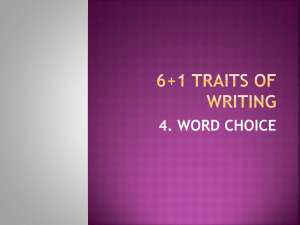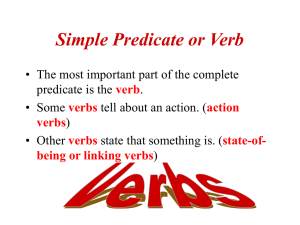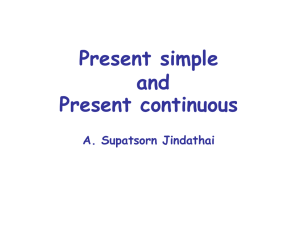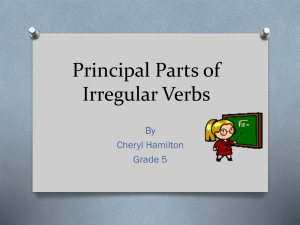Present simple present continuous
advertisement
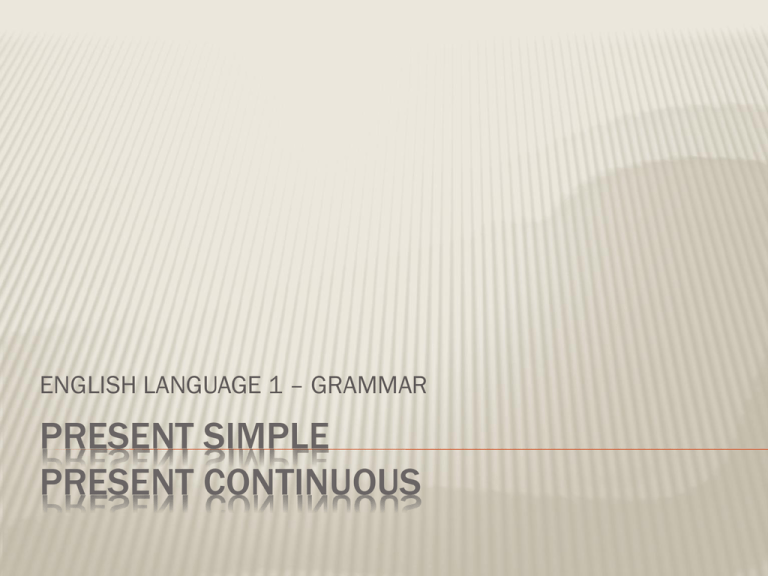
ENGLISH LANGUAGE 1 – GRAMMAR PRESENT SIMPLE PRESENT CONTINUOUS PRESENT TENSES The present simple and the present continuous tenses are the most common ways of expressing present time in English. The present simple describes things that are generally true, while the present continuous describes things that are true at the time of speaking, but which may change. PRESENT SIMPLE PRESENT SIMPLE PRESENT SIMPLE PRESENT SIMPLE PS is used to talk about: Permanent states: - I have a car. - She lives next door. - Smiths never relax. - I don’t like horror films. Permanent actions – laws of nature, scientific facts, general truths… - The moon moves round the earth. - Stress causes high blood pressure. - Water freezes at 0 degrees. - British people drink a lot of tea. - Broken bones in adults don't heal as fast as they do in children. PRESENT SIMPLE Actions that repeat (including daily routines…): - He usually starts work at 8 am. - I often go to the seaside. - We sometimes sleep late. - They seldom take a vacation. - The Blairs take their summer holiday in a quiet part of Tuscany. - Our two chefs provide an excellent choice of hot meals every day. PRESENT SIMPLE With timetables, schedules, programmes: - The bus leaves at 10. - The ferry arrives at 3 pm. - The film starts at 8 pm. - On day 1 we visit the castle and on day 2 we go to the beach. After that you have some time off. PRESENT SIMPLE to describe a series of events or actions (e.g. to give directions or instructions, sports commentaries…), often with impersonal you: - From here you cross the road, go through an iron gate and follow the path west ... - France kicks off, Zidane passes to Henry, Henry cuts inside ... PRESENT SIMPLE If we wish to give the events of a past narrative more immediacy (including anecdotes, plots and summaries of stories, novels, films), we can use the present simple, especially in speech and jokes (historic present): - There's an old woman with thick glasses and a name tag. I go up to her and ask ... - May 1945: The war in Europe comes to an end. - ...At the end of the play both families realise that their hatred caused the deaths of the lovers ... - ... So then the second man asks the first one why he has a banana in his ear and the first one says ... In newspaper headlines: - Morrison gets two years of prison - Ship sinks in midnight collision. PRESENT SIMPLE With state verbs PRESENT SIMPLE An exception to the use of the present continuous to describe actions in progress is Here comes and There goes, which are always in the present simple: - Here comes the postman. - There goes the last bus. Note the inversion of the verb and subject in these phrases. PRESENT SIMPLE We use performative verbs in the first person actually to perform an action, i.e. saying I apologise performs the action of apologising: - On behalf of the company, I apologise for any inconvenience caused. When these verbs 'perform' the function they express, they do not usually take the continuous: - Railtrack apologises for the disruption to services over the last three months. By saying this, the function of apologising is performed. However, if we use the verb to describe the action rather than to do it, we can use the continuous: - The Railtrack chief executive was apologising profusely for the inconvenience. Common performative verbs are: accept, agree, apologise, congratulate, dec/are, deny, disagree, forbid, forgive, guarantee, insist, invite, order, predict, promise, recommend, refuse, request, suggest, thank, warn. PRESENT CONTINUOUS Also called the Present Progressive Tense. PRESENT CONTINUOUS PRESENT CONTINUOUS PC is used for: Actions happening right now: - You are sitting and listening while I am talking. Jerri isn’t doing her homework now. Actions happening these days (around the moment of speaking): - We are studying in the U.S. this month. Laura’s studying in France this year. Are you studying hard these days? She is practicing for her concert these days. I am learning to drive. PRESENT CONTINUOUS For temporary actions: - I'm feeding the neighbour's cat this week while she's in hospital. - Graham's having a tough time at the office at the moment and he's smoking about fifty cigarettes a day! With always, forever, constantly and continually to express annoyance or criticism: - You are always interrupting me! - You are forever making remarks about my cooking! - The neighbours are forever slamming doors and shouting during the night. For fixed arrangements in near future: - He is flying to Milan in an hour. - She is going to Berlin next month. PRESENT CONTINUOUS For changing situations or developing actions: - It is getting dark. - More and more people are giving up smoking. - British summers are getting hotter and winters are getting wetter. PRESENT CONTINUOUS You may hear the present continuous used in sports commentaries, when the action is in progress throughout the time of speaking: - They're now entering the back straight and EI Garrouj is starting to pull away ...( ... but he crosses the line two seconds ahead of his closest rival ...) STATE VERBS WITH DIFFERENT MEANINGS Some verbs of feeling can be used in both the simple and the continuous with no change in meaning: - My wrist hurts/is hurting again. I must go to the physiotherapist. - think those shells may have been off. Do you feel/Are you feeling OK today? ROUND UP

